Служба Windows Error Reporting (WER) служит для сбора и отправки отладочной информации о падении системных и сторонних приложений в Windows на сервера Microsoft. По задумке Microsoft, эта информация должна анализироваться и при наличии решения, вариант исправления проблемы должен отправляется пользователю через Windows Error Reporting Response. Но по факту мало кто пользуется этим функционалом, хотя Microsoft настойчиво оставляет службу сбора ошибок WER включенной по умолчанию во всех последних версиях Windows. В большинстве случае о службе WER вспоминают, когда каталог C:\ProgramData\Microsoft\Windows\WER\ReportQueue\ начинает занимать много места на системном диске (вплоть до нескольких десятков Гб), даже не смотря на то что на этом каталоге по умолчанию включена NTFS компрессия.
Содержание:
- Служба Windows Error Reporting
- Очистка папки WER\ReportQueue в Windows
- Отключение Window Error Reporting в Windows Server
- Отключаем сбор и отправки отчетов об ошибках в Windows 10
- Отключение Windows Error Reporting через GPO
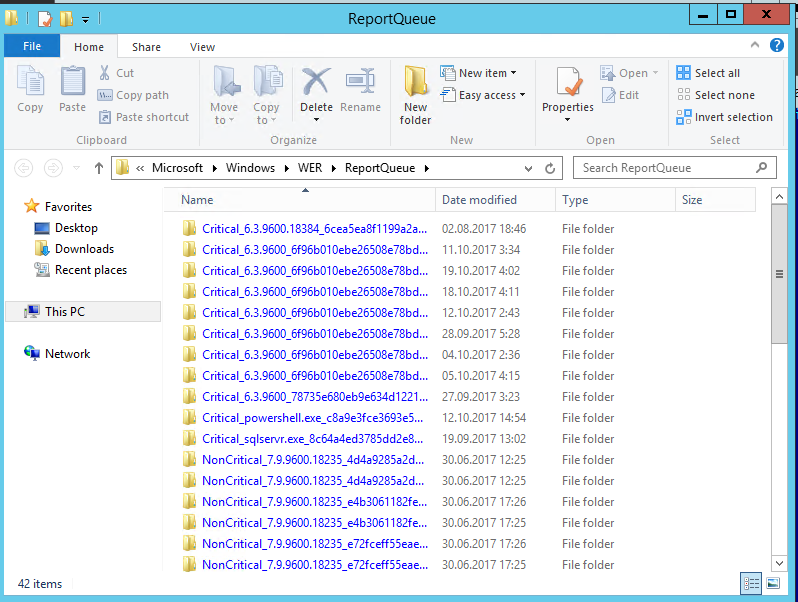
Служба Windows Error Reporting
Служба Windows Error Reporting при появлении ошибки показывает диалоговое окно, предлагающее отправить отчет об ошибке в корпорацию Microsoft. Когда в Windows вы видите сообщение об ошибке
YourApp has stop working
, в это время в служба Windows Error Reporting запускает утилиту WerFault.exe для сбора отладочных данных (могут включать в себя дамп памяти).
Данные пользователя сохраняются в профиль пользователя:
%USERPROFILE%\AppData\Local\Microsoft\Windows\wer
Системные данные – в системный каталог:
%ALLUSERSPROFILE%\Microsoft\Windows\WER\
Служба Windows Error Reporting представляет собой отдельный сервис Windows. Вы можете проверить состояние службы командой PowerShell:
Get-Service WerSvc
Внутри каталога WER\ReportQueue\ содержится множество каталогов, с именами в формате:
- Critical_6.3.9600.18384_{ID}_00000000_cab_3222bf78
- Critical_powershell.exe_{ID}_cab_271e13c0
- Critical_sqlservr.exe__{ID}_cab_b3a19651
- NonCritical_7.9.9600.18235__{ID}_0bfcb07a
- AppCrash_cmd.exe_{ID}_bda769bf_37d3b403
Как вы видите, имя каталога содержит степень критичности события и имя конкретного exe файла, который завершился аварийно. Во всех каталогах обязательно имеется файл Report.wer, который содержит описание ошибок и несколько файлов с дополнительной информацией.
Очистка папки WER\ReportQueue в Windows
Как правило, размер каждой папки в WER незначителен, но в некоторых случаях для проблемного процесса генерируется дамп памяти, который занимает довольно много места. На скриншоте ниже видно, что размер файла дампа memory.hdmp составляет около 610 Мб. Парочка таким дампов – и на диске исчезло несколько свободных гигибайт.

Чтобы очистить все эти ошибки и журналы штатными средствами, откройте панель управления и перейдите в раздел ControlPanel -> System and Security -> Security and Maintenance -> Maintenance -> View reliability history -> View all problem reports (Control Panel\System and Security\Security and Maintenance\Problem Reports) и нажмите на кнопку Clear all problem reports.
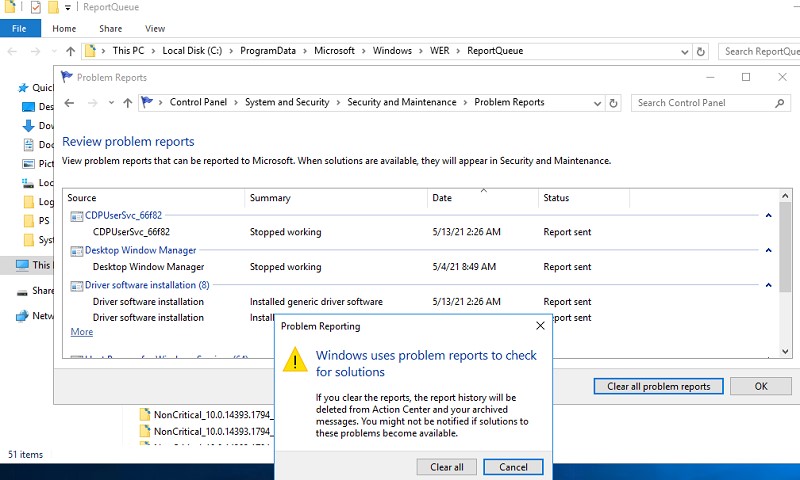
Для быстрого освобождения места на диске от файлов отладки, сгенерированных службой WER, содержимое следующих каталогов можно безболезненно очистить вручную.
- C:\ProgramData\Microsoft\Windows\WER\ReportArchive\
- C:\ProgramData\Microsoft\Windows\WER\ReportQueue\
Следующие команды PowerShell удалят из каталога каталогов WER все файлы, старше 15 дней:
Get-ChildItem -Path 'C:\ProgramData\Microsoft\Windows\WER\ReportArchive' -Recurse | Where-Object CreationTime -lt (Get-Date).AddDays(-15) | Remove-Item -force -Recurse
Get-ChildItem -Path 'C:\ProgramData\Microsoft\Windows\WER\ReportQueue' -Recurse | Where-Object CreationTime -lt (Get-Date).AddDays(-15) | Remove-Item -force –Recurse
Для очистки каталогов WER в пользовательских профилях используйте такой скрипт:
$users = Get-ChildItem c:\users|where{$_.name -notmatch 'Public|default'}
foreach ($user in $users){
Get-ChildItem "C:\Users\$User\AppData\Local\Microsoft\Windows\WER\ " –Recurse -ErrorAction SilentlyContinue | Remove-Item –force –Recurse
}
Отключение Window Error Reporting в Windows Server
В Windows Server 2019/2016/2012R2 вы можете управлять состоянием WER с помощью PowerShell. Вы можете отключить службу Windows Error Reporting:
Get-Service WerSvc| stop-service –passthru -force
Set-Service WerSvc –startuptype manual –passthru
Но есть более корректные способы отключения WER в Windows. В версии PowerShell 4.0 добавлен отдельный модуль WindowsErrorReporting из трех командлетов:
Get-Command -Module WindowsErrorReporting

Проверить состояние службы Windows Error Reporting можно командой:
Get-WindowsErrorReporting
Для отключения WER, выполните:
Disable-WindowsErrorReporting

В Windows Server 2012 R2 можно отключить запись информации об ошибках Windows Error Reporting через панель управления (Control Panel -> System and Security -> Action Center -> раздел Maintenance -> Settings -> выберите опцию I don’t want to participate, and don’t ask me again
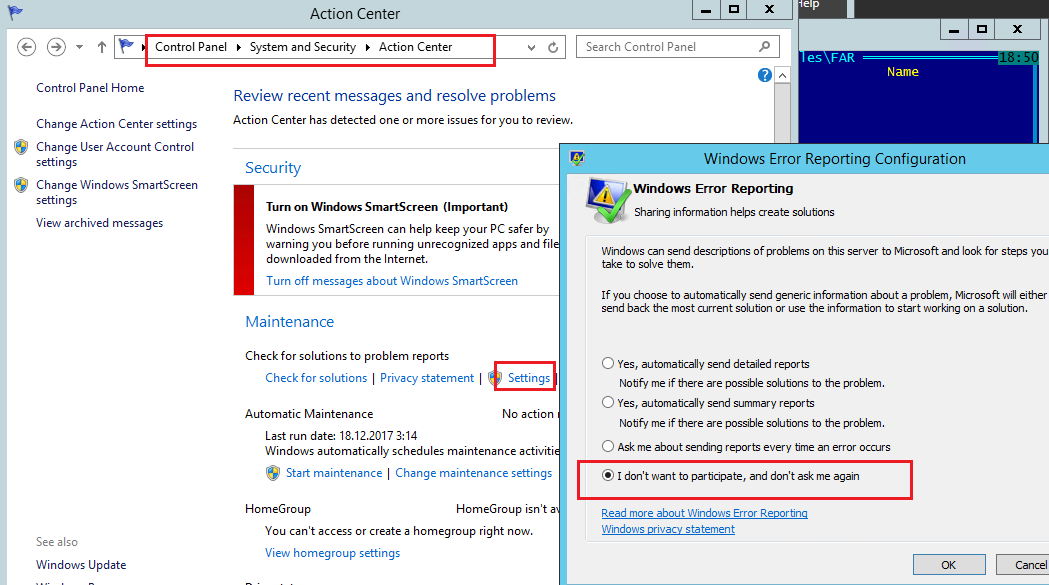
Отключаем сбор и отправки отчетов об ошибках в Windows 10
В Windows 10 нельзя отключить Error Reporting через панель управления. В графическогм интерфейсе можно только проверить ее статус (Система и безопасность ->Центр безопасности и обслуживания -> секция Обслуживание). Как вы видите, по умолчанию параметр Поиск решения для указанных в отчетах проблем включен (Control Panel -> System and Security -> Security and Maintenance -> Maintenance -> Report problems = On).
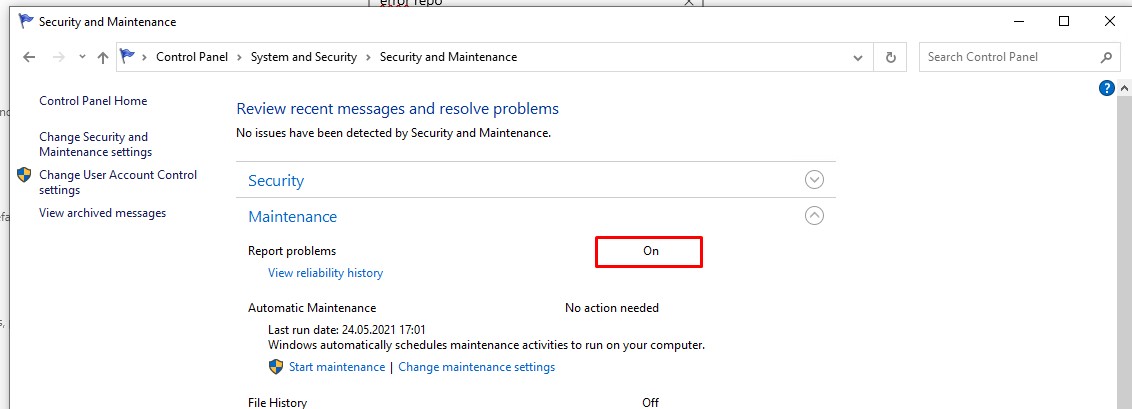
HKLM\SOFTWARE\Microsoft\Windows\Windows Error Reporting нужно создать новый параметр типа DWORD (32 бита) с именем Disabled и значением 1.
Можно отключить сбор ошибок WER для конкретных пользователей:
reg add "HKCU\Software\Microsoft\Windows\Windows Error Reporting" /v "Disabled" /t REG_DWORD /d "1" /f
Или отключить WER для всех:
reg add "HKLM\Software\Microsoft\Windows\Windows Error Reporting" /v "Disabled" /t REG_DWORD /d "1" /f
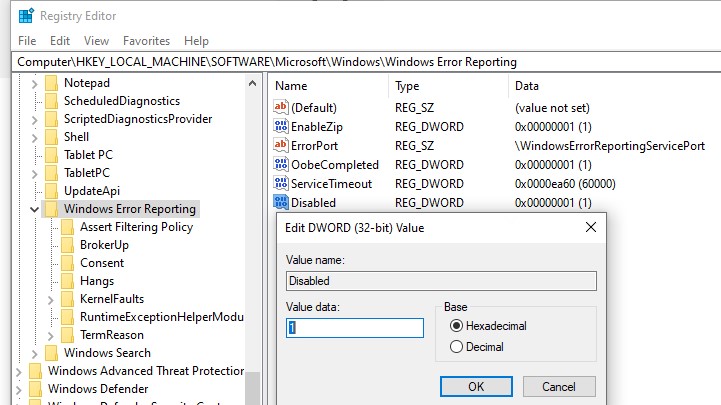
Измените параметр реестра и проверьте статус параметра Поиск решения для указанных в отчетах проблем в панели управления. Его статус должен изменится на Отключено.

Отключение Windows Error Reporting через GPO
Также вы можете управлять настройками службы Windows Error Reporting через групповые политики.
Запустите редактор локальной (
gpedit.msc
) или доменной GPO (
gpmc.msc
) и перейдите в ветку реестра Computer Configuration -> Administrative Templates -> Windows Components -> Windows Error Reporting (Компоненты Windows -> Отчеты об ошибках Windows). Для отключения сбора и отправки ошибок через WER включите политику Disable Windows Error Reporting (Отключить отчеты об ошибках Windows).
Аналогичная политика есть в пользовательском разделе политик (User Configuration).
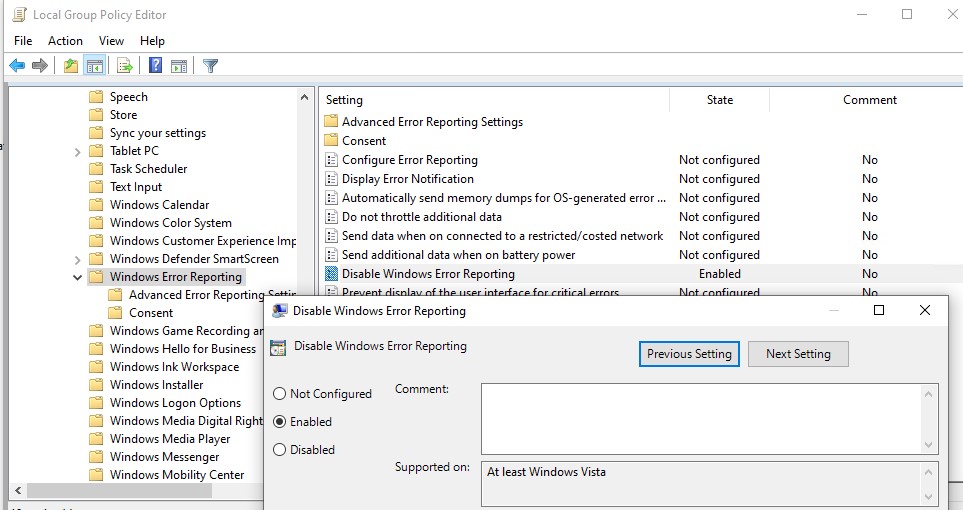
Обновите GPO (перезагрузка не потребуется).
В результате в Windows перестанут формироваться сообщения об ошибках Windows и отправляться в Microsoft.
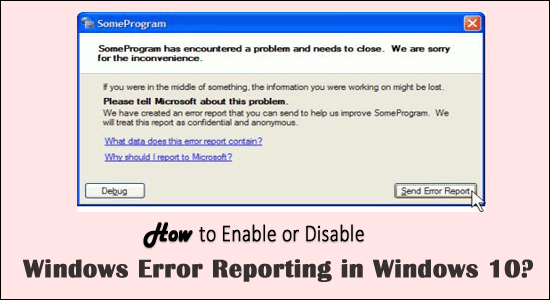
Windows Error Reporting is a service that allows users to send all the operating system errors, alerts related content to Microsoft. The error reporting service is intended to help the user to ensure the PC works optimally.
When Your PC/Laptop hangs or crashes then OS immediately sends an error report to Microsoft automatically. If the solution is available then Microsoft will send you fixes but if not then they try to find the solutions.
And in every Windows version, the service is enabled by default, so whenever you will face any error then the Windows system sends an error report to Microsoft automatically.
Windows Error Reporting is enabled by default. And when you send general information about errors than Microsoft (For more you can visit the official page: https://technet.microsoft.com/en-us/library/cc754364(v=ws.11).aspx) will send back either the most current fix or use the information to find a perfect solution for the related issue.
Well, the Windows error reporting feature always prompt you to send the information about the problem to Microsoft whenever a certain program or operating system encounter issues.
And this is the reason many users are searching how to disable error reporting feature, in order to:
- Prevent the system from sending private information about your computer to Microsoft
- To avoid annoying alerts along with the error message
- The error reporting can’t help to fix the problem all the time.
The Microsoft Error Reporting service becomes irritating sometimes and becomes necessary to stop this service.
So, in this article, I am sharing with you the best possible ways on how to disable or enable error reporting services on Windows 10 as well as Windows 8 & 7.
Well, you can disable the error reporting in Windows 10 in three different ways. Follow the steps listed to disable the service easily.
Step 1 – Disable Error Reporting via Registry Editor
If you are good at following the commands then follow the steps listed to disable Windows Error Reporting service through the Registry Editor.
Follow the steps to do so:
- Press Windows + R key > to type regedit > click OK
- Now in the Registry Editor > locate the listed address
- HKEY_LOCAL_MACHINE\SOFTWARE\Microsoft\Windows\Windows Error Reporting.
- Then right-click the Windows Error Reporting key > click New > DWORD (32-bit) Value.
- Now right-click on the new DWORD value > rename it to Disabled.
- Next double click on it > to set the value data to 1 > click OK for saving the changes.
Well, the Windows Error Reporting is successfully disabled on your Windows 10 system. Now open the Control panel and verify the error reporting service status, it must be changed from On to Off.
Step 2 – Disable Windows Error Reporting via Services
If you are Windows 10 user then learn how to turn off Windows error reporting service in Windows 10 through services:
- Press Windows + R button > to open Run box > type services.msc > press Enter key
- Now search for the Windows Error Reporting Service > right-click on the entry from the list.
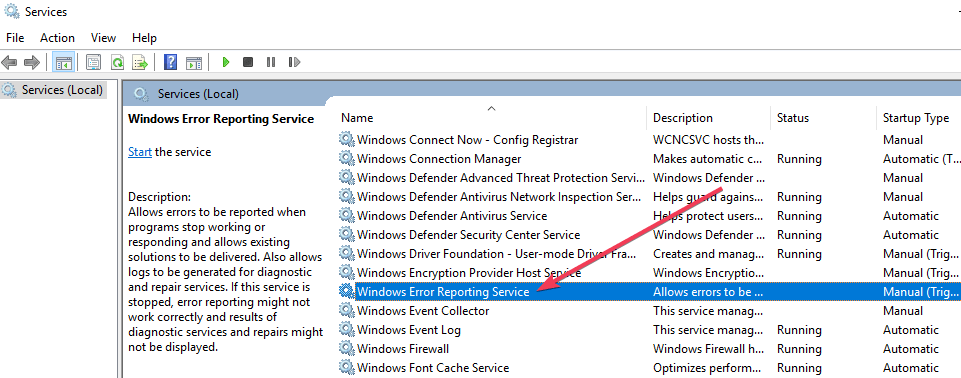
- After right-clicking, you need to select the Properties option.
- Go to the Startup type and from the dropdown menu choose Disabled.
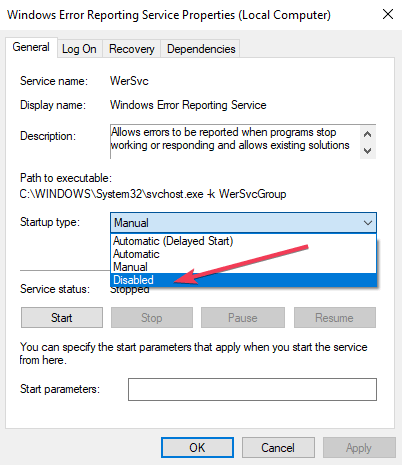
- Click OK or Apply to save the modifications.
- Exit from the Services window and reboot your system.
The Error Reporting service in Windows 10 is disabled now.
Step 3 – Turn off Windows Error Reporting via Group Policy
Here follow the steps to disable the Windows error reporting service through the group policy.
- Press Windows + R keys > and in the Run box type gpedit.msc > click OK
- Now in the Group Policy editor> browse to Computer Configuration and click Administrative Templates and Windows Components > click Windows Error Reporting.
- Then on the right-side click on Settings and locate the Disable Windows Error Reporting option > double click on it.
- Select Enabled > Apply > OK for saving changes.
Now the Windows error reporting feature is disabled successfully on Windows 10.
How to Disable Error Reporting in Windows 8 & Windows 7?
Well, the steps to disable error reporting service is same for the both Windows 8 and 7 OS. So, follow the steps given carefully.
- Go to the Control Panel and click on the System and Security link.
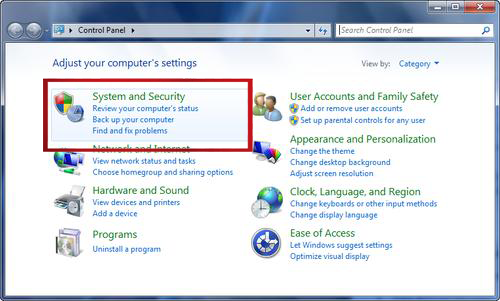
- Click on the Action Center link.
- Now, in the Action Center window, click/tap the Change Action Center settings link on the left.

- Click on the Problem reporting settings link present in the “Related settings” section at the bottom of the “Change Action Center settings” window.
Here you will found four Problem Reporting Settings options:
-
- Automatically check for solutions (the default option)
- Automatically check for solutions and send additional report data, if needed
- Each time a problem occurs, ask me before checking for solutions
- Never check for solutions
- Select Never check for solutions will completely disable error reporting in Windows.

Note: If you want to partially disable this service then you should choose Each time a problem occurs, ask me before checking for solutions.
- After it, click the OK button present at the bottom of the window.
- Click the OK button present at the bottom of the Change Action Center settings window.
- After all, exit from the Action Center window.
The Windows error reporting feature is disabled successfully now.
Now if after disabling the Windows error reporting feature on Windows 10, wondering how to enable service in Windows 10, then learn how to do so:
How to Enable Windows Error Reporting in Windows 10?
If you are looking to enable error reporting service in Windows 10 then simply follow the below-given steps:
- Press Windows + R keys > click on the Run after it type oobe and > press Enter.
- Click on the Enable automatic updating and feedback in the Update This Server area.
- Click on the Manually configure settings.
- After it, in the Windows Error Reporting area of the Manually Configure Settings dialog box, click on the Change Setting.

- Now you need to configure the Windows Error Reporting Service, in the Configuration dialog box select one of the following options.
-
- Yes, automatically send detailed reports
- Yes, automatically send summary reports
- Save them by clicking on OK
- On the Manually Configure Settings dialog box, click Close.
And that’s it now your Windows error reporting service is enabled in Windows 10 OS.
Is it Safe to Disable Windows Error Reporting Service?
Well, disabling the Windows error reporting service won’t impact the system performance but if everyone starts disabling the windows error reporting then this will be harder for Microsoft to know about the background problems encountered by the users.
And ultimately getting immediate support and improvements may get delayed.
Make Your Windows PC/Laptop Error-Free
Well if you are encountering various Windows PC/laptop errors or your system is running slow then here it is suggested to scan your system with the PC Repair Tool.
This is an advanced repair tool, that just by scanning once detect and fix various PC problems including BSOD error, repair the corrupted Windows system files, DLL errors, registry errors, prevent virus or malware infection, and much more.
This not only fixes errors but also optimizes your Windows PC performance like a new one to optimize the gaming performance.
Get PC Repair Tool, to make your PC Error-Free & Speed up
Conclusion:
Well, the Windows Error Reporting service is one of the useful things and it helps the user to fix the appeared issue.
But, if in case you want to get rid of Error Report Service notification along with the errors or have concerns about privacy then you should immediately disable the error reporting service.
Here, you can follow the steps to apply the steps based on different Windows versions and avoid the error reporting service to fetch any personal information.
Hope the article works for you.
Hardeep has always been a Windows lover ever since she got her hands on her first Windows XP PC. She has always been enthusiastic about technological stuff, especially Artificial Intelligence (AI) computing. Before joining PC Error Fix, she worked as a freelancer and worked on numerous technical projects.
Windows 10 has an in-built feature “Error Reporting service” that helps in coordinating issues between Microsoft and Windows users. The experts have developed this tool to receive bugs-report from users PC so that they start working on the issue immediately afterward. Their prime focus is to make sure that your PC runs smoothly and optimally. Though this tool comes as pre-enabled on Windows 10 devices, we explore ways to either enable or disable Error Reporting Service on your PC.
Windows Error Report looks for hardware as well as software anomalies on your computer and if discovered will pass on the relevant information to Microsoft. The company, after receiving the entails, start working on the solutions. As soon as they discover the core fault, provide the troubleshooting guide to the users. While doing so, they capture some basic details like name, date and time of the error, OS version, etc. Today, in this tutorial, we depict two different workarounds to enable or disable Error Reporting Service on Windows 10 PC.
Should one turn off this service
The main reasons which force windows users to often disable Error Reporting service are due to privacy concerns or low disk spaces. If turned on, this provides dual benefits to both Microsoft as well as Windows users. The company looks over several errors report and develop an advanced algorithm to deal with these bugs. In this way, they provide a better user experience based on issues under these reports.
Before proceeding to workarounds, one should be certain whether the above service is enabled or disabled. To do so, follow these easy steps-
- Navigate to the following address on your PC- Control Panel > System and Security > Security and Maintenance.
- Here, search for the report issues. In general, this should display “ON” if you haven’t configured the same at some earlier point.
You may turn on or off this service via two different workarounds and they are-
- Using Windows Services
- Via Registry Editor
Note: The Error reporting service of Windows 10 appears under Security & Maintenance while for earlier versions, it lies under Action Center.
If you want to disable the above service on different Windows version, just select your particular OS from the following list-
- Error Reporting service on Windows 8 or Windows 7
- Problem Reporting service on Windows Vista
- Problem Reporting service on Windows XP
1} Via Windows Services
Here’s how to enable or disable the Error reporting service on Windows 10 PC-
- Make a right-click on the Win icon and select the Run option.
- Type services.msc in the void then hold down the Ctrl+Shift keys and press the Enter key to cite Windows Services.
- Here, switch to the adjacent right-screen and scroll down to locate the “Windows Error Reporting Service” entry.
- Perform a right-click on the above entry and select the “Properties” option.

- Henceforth, locate the Startup type and choose “Disabled” on the drop-down menu next to this.

Note:
- In certain scenarios, you might not be able to perform the above changes in the Startup type. This simply implies that you require administrative privileges to perform the above action.
- To re-enable this service, all you require is to follow the above steps and choose the “Automatic” option.
Lastly, hit the OK button to get out of the current window. Do Restart your PC to confirm the above changes.
2} Using Registry Tweaks
Registry Editor is the best workaround to turn off the Error Reporting service on Windows 10 PC. All you need is to adjust a few entries as illustrated in the following steps-
Step-1: At first, press Win+R to invoke Run dialog and type “Regedit” followed by the Enter Key.
Step-2: If UAC prompts, tap Yes to start the Registry Editor.
Step-3: On the succeeding screen, navigate to the following path-
HKEY_LOCAL_MACHINE\SOFTWARE\Microsoft\Windows\Windows Error Reporting
Step-4: Here, switch to the adjacent right-screen and locate the “Disabled” entry.
Step-5: Perform a click on the above entry to open it and replace the value “0” with “1”. Subsequently, press the OK button to save the changes.

Step-6: If there is no such entry, create a new one and name this “Disabled”. Thereupon, perform the step-5.

At last, tap OK so that changes made so far come into effect.
Note:
- To create a new DWORD value, simply right-click anywhere on the Registry Editor and follow New > DWORD (32-bit) value.
- The value “0” represents enabling whereas “1” disabling, hence you may enable this registry whenever you want to do so in the future.
Enable or Disable Error Reporting Service in Windows 7/8
- At first, launch the Control Panel henceforth select “System and Security” category.
- Next, click Action Center followed by Change Action Center Settings on the left column.
- Subsequently, select Problem reporting settings option on the Related settings section available at the bottom.
- Here, you will see four different options which are as follows-
- Automatically check for solutions (the default one)
- Automatically check for solutions and send additional report data, if needed
- Each time a problem occurs, ask me before checking for solutions: This is the best option if your prime concern is privacy.
- Never check for solutions (not recommended as per the company)

There’s even an extra option selecting which you may select particular programs that won’t report any errors to Microsoft. However, as this requires heavy customization, proceed only if you are really interested.
In case, you are not able to perform any changes, select the “Change report settings for all users option”.
- Lastly, hit the OK button on “Problem Reporting Settings” as well as “Change Action Center settings”.
That’s it, you may now close the Action Center window. Do Restart your PC to save the changes made so far.
Enable or Disable Error Reporting service in Windows Vista
Follow these easy steps to turn on or off the above service on Windows Vista-
- Hit the Start button and select the Control Panel option.
- Here, click “System and Maintenance” henceforth “Problems Report and Solutions“.
- Switch over to the left side and select “Change Settings” button.
- Next, select either of these options-
- Check for solutions automatically
- Ask me to check if a problem occurs
If you are worried about sending information to the company, select any one of the options listed above and close the current window. This will keep error reporting service turned On, however, it won’t allow Microsoft sending you any new notification regarding any new error.
To disable the error reporting service completely, you should follow the remaining steps as well.
- Tap the Advanced settings and disable the “For my programs, problem reporting is:” radio button.
- Lastly, hit the OK button on each and every running window.

That’s it, Restart your PC to save the changes performed so far.
Enable or Disable Error Reporting service in Windows XP
Follow these easy steps to turn on or off the above service on Windows XP-
- At first, hit the Start Menu and select Control Panel.
- On succeeding screen, select “Performance and Maintenance“.
- Here, select System henceforth Advanced tab on the subsequent pop-up window.
- At the bottom, you may see the Error Reporting tab, hit the same and enable the Disable error reporting radio button.
Note: Make sure to leave the checkbox “But notify me when critical errors occur” ticked. Doing so, Windows XP will still notify you about some serious errors, however, Microsoft won’t.
- Lastly, keep on pressing the OK button until you reach the Performance and Maintenance window.
That’s it, you may now close the current window and Restart your PC to save the changes made so far.
In Windows Vista or later, Microsoft introduced Windows Error Reporting (WER) feature. It usually detects hardware and software issues on Windows and report to Microsoft plus provides available solutions to users regarding the issues.
There is no need to additionally turn on Windows Error Reporting feature as it is enabled by default on your Windows operating system.

You won’t notice this feature that is running in background, unless you receive Windows Error Reporting has stopped working message. In that case, the feature is crashing and you need to fix it.
Well, if you ever need to disable Windows Error Reporting feature and later need to enable again, here’s how to do this.
How To Enable/Disable Windows Error Reporting In Windows 10/8.1/8/7
Registry Disclaimer: The further steps will involve registry manipulation. Making mistakes while manipulating registry could affect your system adversely. So be careful while editing registry entries and create a System Restore point first.
1. Press + R and put regedit in Run dialog box to open Registry Editor (if you’re not familiar with Registry Editor, then click here). Click OK.

2. In left pane of Registry Editor window, navigate to following registry key:
HKEY_LOCAL_MACHINE\SOFTWARE\Policies\Microsoft\Windows
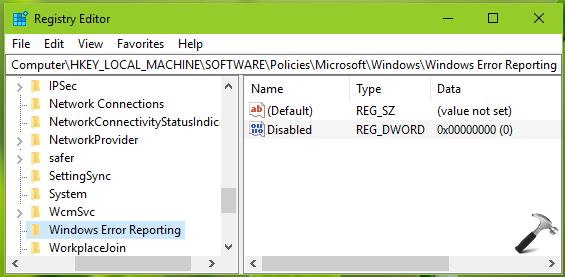
3. Right click Windows registry key, select New > Key. Name the newly created sub-key as Windows Error Reporting. If the registry key already exists, skip creation of new key. Now in the right pane of Windows Error Reporting registry key (HKEY_LOCAL_MACHINE\SOFTWARE\Policies\Microsoft\Windows\Windows Error Reporting), right click and select New > DWORD Value. Name the newly created registry DWORD (REG_DWORD) as Disabled. Double click on the DWORD to modify its Value data:
4. Finally set the DWORD Value data to 1 and this should disable Windows Error Reporting. Click OK, close Registry Editor and reboot the machine to make changes effective.
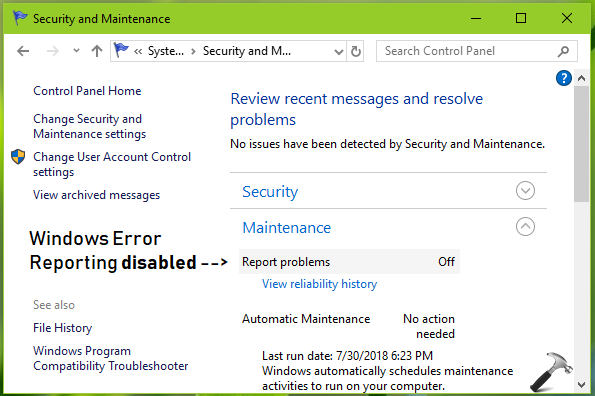
To re-enable Windows Error Reporting later, simply restore Disabled registry DWORD to 0 or delete it.
Group Policy Setting: If you want to disable Windows Error Reporting on multiple machines in your organization/workplace, you can deploy the relevant GPO setting. Configure Disable Windows Error Reporting setting at Computer configuration > Administrative templates > Windows Components > Windows Error Reporting to Enabled.
So this is how you can manage Windows Error Reporting feature in Windows 10.
That’s it!
RELATED ARTICLES
Download Windows Speedup Tool to fix errors and make PC run faster
Whenever a system crashes, using dump files (.dmp), we can easily analyze what has caused the issue. Using dump analysis, errors and crashes can be resolved out. Windows Error Reporting (WER), introduced since Windows Vista, works in the way to collect user-mode dumps. But this feature is not enabled by default in Windows 11/10/8, and a registry trick can be operated to bring it into action.
In this article, I’ll show you how to enable and configure User Mode Dumps creation and collection using Windows Error Reporting service via Windows Registry so that you can easily collect dump files in a folder inside Explorer. Please note that applications that do their own custom crash reporting, including .NET applications are not supported by this feature.
As the User Mode Dumps creation feature is not enabled by default, you can employ the following registry trick to make it live:
1. Press Windows Key + R combination, type put Regedt32.exe in Run dialog box and hit Enter to open the Registry Editor.
2. Navigate here:
HKEY_LOCAL_MACHINE\SOFTWARE\Microsoft\Windows\Windows Error Reporting\LocalDumps
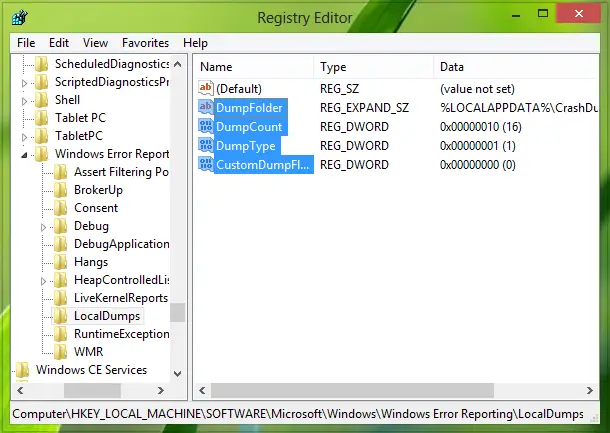
3. In the right pane of this location, you can create different value data to configure WER. Here are the various data you can create here:
A] DumpFolder – (Creation : using Right click -> New -> Expandable String Value)
This string value handles the location to collect crash data in a folder. You can double click the above-created string to modify its Value data. The default Value data should be %LOCALAPPDATA%\CrashDumps.
To find dump files stored after a crash, press Windows Key + R, type %LOCALAPPDATA%\CrashDumps and get the dump files.
B] DumpCount – {Creation : using Right click -> New -> DWORD (32-bit) Value}
The above-created DWORD takes care of how many dump files should be stored at the location created previously in step a. By default, this number is 10.
As the number of files exceeds 10, the oldest files will be erased, and new files will receive their place.
C] DumpType – {Creation : using Right click -> New -> DWORD (32-bit) Value}
This DWORD can be configured to get the dump file as Custom dump; Mini dump; Full dump according to your requirement. Use Value Data 0, 1, 2, respectively.
Thus in this way, you can store the dump files for system crashes. If you’re looking to store dump files for a particular application, then you need to create the subkey to LocalDumps key:
HKEY_LOCAL_MACHINE\Software\Microsoft\Windows\Windows Error Reporting\LocalDumps
For example, if you want to store dump files for ImageReady, a component application of Adobe Photoshop, you can name the subkey as ImageReady.exe. So the subkey can be located as:
HKEY_LOCAL_MACHINE\Software\Microsoft\Windows\Windows Error Reporting\LocalDumps\ImageReady.exe.
Then you can perform step 3 to configure what type of data to be stored for this subkey particularly. Please note that the settings of subkey i.e. ImageReady.exe overrides the setting of the main key i.e. LocalDumps.
Disable User Mode Dumps creation
To Disable User Mode Dumps creation, simply delete the registry key.
Remember to create a system restore point first always.
I hope you find the article useful!
An Electrical Engineer by profession, Kapil is a Microsoft MVP and a Windows Insider MVP. Please read the entire post & the comments first & create a system restore point before making any changes to your system.
